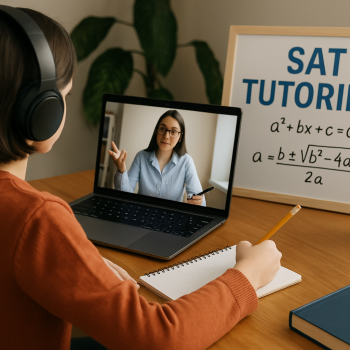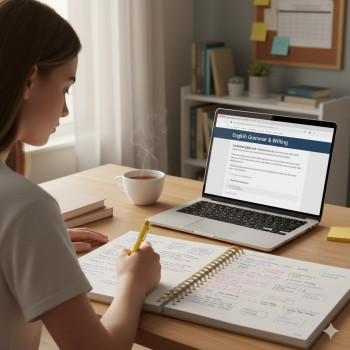Why balancing boundaries and support matters for Digital SAT success
Preparing for the Digital SAT is more than mastering math problems or practicing reading passages — it’s an emotional, logistical, and developmental process. Students are learning to manage time, stress, and responsibility; parents want to help without overstepping. When support becomes pressure, motivation can disappear. When boundaries are too rigid, a student can feel isolated. The sweet spot is intentional, respectful support that encourages independence while offering a safety net.
This guide is for both students and parents: practical, human, and full of real-world examples. We’ll talk about communication, routines, study strategies, conflict resolution, and how targeted help — including one-on-one, personalized tutoring like Sparkl’s — can fit naturally into a respectful approach.
What’s different about the Digital SAT and why that affects boundaries
The Digital SAT changed the delivery and the experience: shorter, adaptive sections, a digital testing platform, and new practice tools. That means study routines look different too. Instead of long paper tests to simulate every weekend, students might practice on devices, build digital stamina, and focus on adaptive strategies. For parents, this shift invites different kinds of support — from tech readiness to keeping the study environment distraction-free — without micromanaging content practice.

Start with shared goals — not rules
Boundaries work best when both sides help create them. Begin with a conversation that frames the season: the Digital SAT is a shared project with a single purpose — to help the student do their best while keeping well.
- Schedule a brief sit-down to discuss hopes, timelines, and non-negotiables (schoolwork, sleep, extracurriculars).
- Ask the student what kind of support they want — resources, time, accountability, or privacy.
- Agree on check-in frequency: a weekly 15-minute update often beats daily interrogations.
Example: Instead of a parent announcing “You will study two hours every night,” try this: “What feels realistic this week? I can help by blocking a quiet study space and checking in on Sunday to see how it went.” That invites ownership and reduces power struggles.
Practical boundary strategies that actually work
Boundaries shouldn’t be theatrical; they should be practical and flexible. Here are tangible strategies that protect both study time and wellbeing.
1. Create a predictable study rhythm
Predictability reduces friction. A rhythm tells the brain when to focus and when to relax.
- Use a weekly planner: block focused sessions (45–70 minutes) and recovery windows.
- Prioritize quality over quantity: two focused 50-minute sessions are better than five unfocused hours.
- Include at least one full-length practice in Bluebook-style conditions every 2–3 weeks to build stamina.
2. Define communication norms
Agree on how you’ll talk about prep so conversations don’t turn into conflict.
- Check-ins are neutral: open with curiosity (“How did practice go?”) not judgment (“Did you finish?”).
- Use a signal for interruptions — a small text or a calendar block — so students aren’t surprised while in a focused block.
- Set boundaries around late-night messaging. Rest matters more than last-minute Q&A.
3. Set realistic expectations — and track them gently
High expectations are fine; unrealistic pressure is not. Track progress with data, not drama.
- Use low-stakes diagnostics to identify focus areas (Algebra, Command of Evidence, timing).
- Keep a simple progress table to monitor practice tests, topics covered, and mood.
| Week | Focus | Practice Sessions | Notes/Feeling |
|---|---|---|---|
| 1 | Algebra fundamentals, pacing | 3 focused sessions, 1 practice set | Confident with linear equations; pacing needs work |
| 2 | Reading: short passages, evidence questions | 4 sessions, 1 timed block | Improved accuracy; timing still tight |
| 3 | Combined problem sets and test practice | 2 sessions, 1 full-length Bluebook simulation | Tired after simulation — more recovery needed |
When to step in (and how)
There are moments when parental intervention is helpful — and other times when stepping back is the better gift. Here’s how to tell the difference:
- Step in when logistics get in the way: registration deadlines, technical setup for Bluebook, or when a student misses practice due to a scheduling error.
- Step back when the issue is motivation or confidence; this is often an opportunity for the student to practice problem-solving and resilience.
- Offer specific help: “I can book your test slot tomorrow,” or “Do you want me to find a tutor who can do one focused session per week?” Specific offers are easier to accept than vague “Do you need help?”
Using professional help without usurping independence
Bringing in a tutor or a program can be a respectful way to support prep without micromanaging. Tailored, expert guidance provides structure while still keeping the student in charge of daily work. For example, Sparkl’s personalized tutoring offers one-on-one guidance, tailored study plans, and AI-driven insights that help students focus on the precise skills they need — parents can coordinate scheduling and payments while the student owns the learning.
How to manage conflicts when tensions rise
Conflict is normal. What matters is how you handle it.
Common flashpoints and scripts that defuse them
- Flashpoint: Missed practice
- Script: “I noticed you missed your session yesterday. Are you OK? If you want to reschedule, I can help set a new time.”
- Flashpoint: Test-anxiety meltdown
- Script: “I can hear how worried you are. How about we take 20 minutes, step away, and then make a small plan together?”
- Flashpoint: Over-involvement from parent
- Script (for parents to self-check): “I’m feeling anxious about this. I’m going to take a breath and let you lead on prep, but I’m here if you need me.”
Practical tools and habits to reinforce boundaries
Tech and routines can make boundaries feel less like rules and more like helpful scaffolding.
Digital habits that protect focus
- Use device focus modes during timed practice to mirror Bluebook conditions.
- Schedule phone-free windows at home during intense study blocks. A small whiteboard or sticky note can signal “Do not disturb.”
- Keep a shared calendar for registrations, tutoring sessions, and test dates so everyone knows the plan without repeated reminders.
Healthy routines that fuel performance
- Prioritize sleep — cognitive performance drops significantly with sleep loss.
- Encourage short exercise and breaks during long study days to reset focus.
- Plan nutritious snacks and avoid last-minute all-nighters before full-length practice tests.

How to use practice data without weaponizing it
Data — practice scores, question logs, timing charts — is gold. But if presented as a scoreboard for approval, it becomes toxic. Use data as a conversation starter and planning tool.
- Celebrate small wins: a timing improvement, a tricky concept unlocked, or a week without stress-related fights.
- Turn questions missed into a micro-plan: 3 targeted problems + one concept review = a clear next step.
- Keep score transparent but private: students may prefer tutors or themselves to own the data while parents get high-level summaries.
Designing study blocks that respect autonomy
Micromanaging is tempting, but autonomy builds long-term study capacity. Here’s how to scaffold without controlling:
- Offer choices: “Would you like to do math first today or reading?”
- Provide resources, not mandates: curated practice sessions, a recommended checklist, and optional tutor sessions.
- Set up accountability that’s student-led: a weekly progress email drafted by the student, or a short planning meeting they run.
When a student resists — read the signal
Resistance can mean many things: burnout, fear, not knowing where to start, or that the timing is off. Instead of escalating, probe gently.
- Ask open questions: “What’s one thing about studying that’s frustrating right now?”
- Offer alternatives: drop a subject for a week and return, switch formats, or bring in a short-term tutor to rebuild confidence.
- Normalize the pause: sometimes a planned break recharges a student and creates better momentum later.
Sample weekly plan that honors boundaries and progress
Below is a sample framework that balances focused study with downtime. It’s adaptable and intentionally light on hourly demands so there’s room for life.
| Day | Morning | Afternoon | Evening |
|---|---|---|---|
| Monday | School | 45-min math focus (practice & review) | Light reading practice (30 min) |
| Tuesday | School | 45-min grammar & evidence practice | Free time / extracurricular |
| Wednesday | School | 1-hour tutor session (if used) | Short timed set (30 min) |
| Thursday | School | Targeted problem set | Rest & hobbies |
| Friday | School | Light review | Family time |
| Saturday | Bluebook-style practice (every 2–3 weeks) | Analyze mistakes with notes | Recovery |
| Sunday | Plan for the week + short review | Free | Optional check-in |
How tutors and tools can strengthen boundaries
Tutors and structured tools reduce friction: they provide a neutral expert voice and a clear plan so parents don’t have to fill that role. A tutor can be the bridge between parental support and student autonomy — offering tailored lessons, targeted practice, and objective feedback.
One-on-one tutoring, when used thoughtfully, respects boundaries by:
- Creating a predictable weekly commitment that parents can schedule without micromanaging daily study.
- Delivering personalized study plans so the student knows exactly what to work on between sessions.
- Providing expert, impartial feedback that reduces emotional friction in parent-student conversations.
For families considering professional help, look for tutors who listen to the student’s goals, adapt to their learning style, and coordinate — only as needed — with parents. That balance maintains student ownership while leveraging professional expertise. Sparkl’s tutoring model, for example, emphasizes tailored plans, 1-on-1 guidance, and AI-driven insights to focus effort efficiently while keeping the student in control of the day-to-day work.
Preparing for test day with respect and calm
The final days before the test are a moment to practice the boundary skills you’ve built: encourage rest, keep conversations calm, and let the student lead logistics where possible.
- Confirm test logistics together (time, ID, device setup) but avoid last-minute drills that spike anxiety.
- Offer practical support: pack a snack, check device battery, and provide quiet transportation if needed.
- Keep the morning light; high-intensity cramming rarely helps and often harms confidence.
Real-world examples: what works
Example 1 — The Negotiated Routine: Emma, a junior, agreed with her parents to four focused sessions a week and one tutor session. Her mother handled scheduling and payments, Emma chose topics and tracked progress, and the family agreed on no testing talk after 9pm. Result: fewer fights, steady score improvement, and Emma felt ownership.
Example 2 — The Data Contract: Malik’s family used a simple agreement — he would share one weekly summary of practice results. His father promised no commentary unless asked. The contract reduced daily tension and made weekly reflection constructive. Result: Malik became more honest about struggles and accepted targeted tutoring for geometry gaps.
Final thoughts: boundaries are a practice, not a rule
Boundaries change as the student grows. What’s respectful at 16 might not fit at 18. The principle to hold onto is this: aim for support that empowers, not control that diminishes. Create structures that respect privacy and agency, use data to guide not to shame, and introduce professional help when it preserves the relationship and the student’s autonomy.
Preparation for the Digital SAT is a shared journey. With clear communication, predictable routines, and occasional expert help, families can preserve harmony and help students reach their potential. And remember: a calm, respectful approach often builds the most resilient learners — ready for test day and beyond.
Quick checklist to get started this week
- Hold a 20-minute kickoff meeting to set goals and communication norms.
- Create a simple weekly study rhythm with 2–4 focused sessions.
- Decide on one professional support option if needed (tutor, skill-specific course, or targeted Bluebook simulations).
- Set tech and sleep rules during high-focus blocks.
- Schedule a neutral weekly check-in — student-led when possible.
Good luck. Respect, patience, and a little planning go a very long way. If you want help designing a tailored plan or finding a tutor who prioritizes student autonomy, consider exploring personalized tutoring options that offer 1-on-1 guidance and tailored study plans — they can take a lot of the logistical burden off families while keeping the student firmly in the driver’s seat.
















No Comments
Leave a comment Cancel